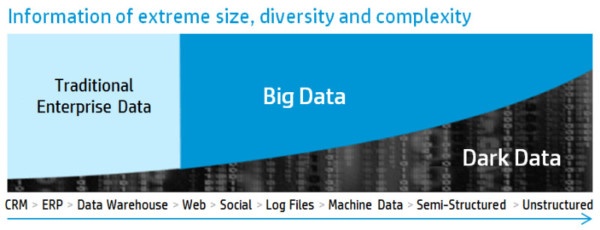In this era of digitization we collect and store more data than ever before. Most of the data we collect is used to improve the way we do business. However, even though we deal with an enormous amount of valuable data, there is an increasing amount of information which we store that has no real tactical value. This unstructured and unmanaged information is called “dark data”.
Dark data might be a new term but it’s not a new problem. Let’s go deeper to understand what dark data is, how it can impact your organization and the steps you need to take to manage it within your organization.
What is Dark Data?
Dark data is a type of untapped, unstructured and untagged data that is found in data repositories and has not been processed or analyzed. It could be anything, such as outdated customer information, previous employee data, log files or email correspondences.
Dark data is also known as dusty data and according to IDC up to 90 percent of big data can be classified as dark data.

What Is the Problem with Dark Data?
Increased Storage Costs
The biggest problem with dark data is the concern of storage space. It takes up storage space unnecessarily which could otherwise have been used for valuable data. As a result, you need to use more storage space which in turn means more overhead expenses.
Security Risks
Dark data is mostly outdated and seemingly useless information, but it can also be sensitive or proprietary information. Simply because you or your employees think it is useless doesn’t mean hackers won’t be willing to access it to jeopardize your business.
Here are a couple of security risks associated with unauthorized access to your dark data.
- Legal: Exposure of your dark data, which includes financial information or patient records, could involve financial and legal liability.
- Intelligence: Any disclosure of your proprietary information, such as data related to partnerships, joint ventures and business operations, could compromise your important business relationships and activities or affect your bottom line.
- Reputation Risk: Any kind of data breach could badly affect your organization’s reputation, which has been built over the years, in no time.
- Opportunity Expenses: Any exploitation of your dark data that offers valuable insights to third parties could represent a potential loss of intelligence.
How Can You Manage Dark Data?
Here are few ways you can manage dark data well:
Audit Your Database Regularly
Conduct periodic audits of your entire database to control your dark data. Additionally, you should have a process in place to reduce old information to give a better structure to your legacy data over time, so that you can easily analyze what is important and for what time period.
Have a Modern Backup Solution
If your backup plan includes traditional full backups of your entire database, then it means that you are constantly duplicating and storing all that unorganized and useless data repeatedly.
You should go for a modern backup solution that will enable you to make differential or incremental backups, so that you can copy your dark data over only once every time you backup your data.
Encrypt Your Data
Both your legacy and dark data should be encrypted to protect your organization from today’s dynamic threat landscape. A strong encryption should be used for your data stored both in-house and offsite and on your cloud server and not just data stored on the former.
Remember, old is gold so the data you might consider useless could turn out to be an untapped potential that could truly be valuable to your organization.
So when do you plan on managing your dark data better? Were you already familiar with this concept? Please feel free to leave your comments below.
- Plex servers compromised and held for ransom - July 10, 2015
- MasterCard is testing a treat for selfie lovers - July 7, 2015
- Amazon launches new plan to pay some authors based on number of pages read - July 6, 2015




Comments are closed.